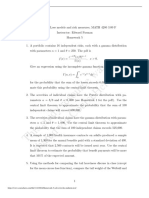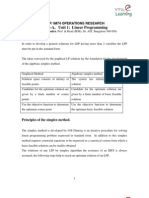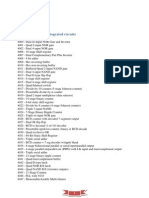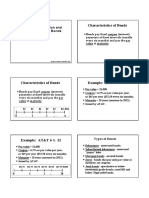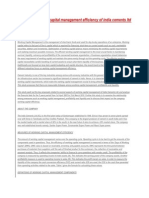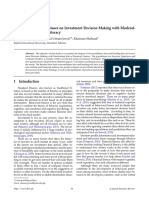Case 1: C Case 2: Cap Market, No Production. C
Case 1: C Case 2: Cap Market, No Production. C
Uploaded by
joeydanzaCopyright:
Available Formats
Case 1: C Case 2: Cap Market, No Production. C
Case 1: C Case 2: Cap Market, No Production. C
Uploaded by
joeydanzaOriginal Description:
Original Title
Copyright
Available Formats
Share this document
Did you find this document useful?
Is this content inappropriate?
Copyright:
Available Formats
Case 1: C Case 2: Cap Market, No Production. C
Case 1: C Case 2: Cap Market, No Production. C
Uploaded by
joeydanzaCopyright:
Available Formats
Case 1: C0=Y0, C1=Y1.Case 2: Cap market, no production. C1=(Y0-C0)(1+r)+Y1. Plug in numbers and simplify so C0 is the only variable.
MRS= –(∂U/∂C0)/(∂U/∂C1). set MRS= –(1+r). Plug the equation in for C1 so only variable in equation is C0. Solve for C0 and plug C0 into
C1 equation to solve for C1. Plug C0 and C1 into utility function and solve for utility. Lend Y0-C0.
Case 3: No cap market, production function. C0=Y0–I0. C1=Y1+f(I0). Plug C0 and C1 into utility function and maximize wrt I. Plug I into C0
and C1 to solve for utility. Case 4: Set –f’(I0) = –(1+r) and solve for I0. Set MRS= –(1+r) and simplify to make C1= expression. Plug all
numbers into Y0–I0+(Y1+f(I0))/(1+r)= C0+(C1/(1+r)) so C0 is the only variable. Solve for C0. Plug C0 in to C1 = expression. Plug C0 and 1
into utility function. Min utility function: set C0=C1
Always choose investment decision with highest NPV. Set –f’(I0) = –(1+r) to solve for I*. NPV= –I*+ (f(I*))/(1+r).
When cap market exists, I is determined by production function and interest rate (independent of preferences and endowments).
When no cap market exists, I depends on both the preferences and endowments of the individual.
𝑟𝑠 𝑚 𝐶 𝐶1
𝑟𝑒𝑓𝑓 = (1 + ) − 1 𝐴 = 𝑃𝑒 𝑟𝑡 𝑃𝑉 𝑜𝑓 𝑃𝑒𝑟𝑝𝑒𝑡𝑢𝑖𝑡𝑦 = 𝑃𝑉 𝑜𝑓 𝐺𝑟𝑜𝑤𝑖𝑛𝑔 𝑃𝑒𝑟𝑝𝑒𝑡𝑢𝑖𝑡𝑦 =
𝑚 𝑟 𝑟−𝑔
𝐶 1 𝐶 1
𝑂𝑟𝑑𝑖𝑛𝑎𝑟𝑦 𝐴𝑛𝑛𝑢𝑖𝑡𝑦 = [1 − 𝑡
] 𝐴𝑛𝑛𝑢𝑖𝑡𝑦 𝐷𝑢𝑒 (𝑃𝑎𝑦𝑚𝑒𝑛𝑡𝑠 𝑎𝑡 𝑏𝑒𝑔𝑖𝑛𝑛𝑖𝑛𝑔 𝑜𝑓 𝑝𝑒𝑟𝑖𝑜𝑑) = [1 − ] (1 + 𝑟)
𝑟 (1 + 𝑟) 𝑟 (1 + 𝑟)𝑡
𝐶1 1+𝑔 𝑇
𝑃𝑉 𝑜𝑓 𝐺𝑟𝑜𝑤𝑖𝑛𝑔 𝐴𝑛𝑛𝑢𝑖𝑡𝑦 = [1 − ( ) ]
𝑟−𝑔 1+𝑟
𝑟
Mortgage rates are quoted annually with semi-annual compounding. You need monthly payments. (1+rm)12 = (1+ )2 Always make it
2
so both sides are 1 year
𝑟
𝑀𝑜𝑛𝑡ℎ𝑙𝑦 𝑝𝑎𝑦𝑚𝑒𝑛𝑡 = 𝐶 = 𝐴 [ ] 𝐴 = 𝑡𝑜𝑡𝑎𝑙 𝑙𝑜𝑎𝑛 𝑇𝑜𝑡𝑎𝑙 𝑖𝑛𝑡𝑒𝑟𝑒𝑠𝑡 𝑝𝑎𝑖𝑑 = 𝑛𝐶 − 𝐴
1 − (1 + 𝑟)−𝑛
n= number of payments = 12*years
1 − (1 + 𝑟)−𝑛+𝑘−1
𝑃𝑟𝑖𝑛𝑐𝑖𝑝𝑙𝑒 𝑜𝑢𝑡𝑠𝑡𝑎𝑛𝑑𝑖𝑛𝑔 𝑎𝑡 𝑏𝑒𝑔𝑖𝑛𝑛𝑖𝑛𝑔 𝑜𝑓 𝐾𝑡ℎ 𝑝𝑒𝑟𝑖𝑜𝑑 = 𝐶 [ ]
𝑟
1 − (1 + 𝑟)−𝑛+𝑘−1 1 − (1 + 𝑟)−𝑛+𝑘−1
𝐼𝑛𝑡𝑒𝑟𝑒𝑠𝑡 𝑖𝑛 𝐾𝑡ℎ 𝑝𝑎𝑦𝑚𝑒𝑛𝑡 = 𝐶(𝑟) [ ] 𝑃𝑟𝑖𝑛𝑐𝑖𝑝𝑙𝑒 𝑐𝑜𝑛𝑡𝑎𝑖𝑛𝑒𝑑 𝑖𝑛 𝐾𝑡ℎ 𝑝𝑎𝑦𝑚𝑒𝑛𝑡 = 𝐶 − 𝐶(𝑟) [ ]
𝑟 𝑟
1+𝑟𝑛𝑜𝑚𝑖𝑛𝑎𝑙
1 + 𝑟𝑟𝑒𝑎𝑙 = 𝑟𝑛𝑜𝑚𝑖𝑛𝑎𝑙 ≈ 𝑟𝑟𝑒𝑎𝑙 + 𝑖. = 𝑖𝑓 𝑐𝑜𝑛𝑠𝑡𝑖𝑛𝑢𝑜𝑢𝑠𝑙𝑦 𝑐𝑜𝑚𝑝𝑜𝑢𝑛𝑑𝑒𝑑. Fisher’s theory: when expected real return is
1+𝑖𝑛𝑓𝑙𝑎𝑡𝑖𝑜𝑛
constant, change in nominal is due to change in expected inflation. Coupon rates are bond specific. In contrast, the spot
rates are market-wide. YTM for zero coupon bond = spot rate. Bond arbitrage: borrow/sell at low rate and lend/buy at high rate. For
there to an arbitrage opportunity, the spot in the year needs to be greater than or equal to 0. First, calculate your profit (1+rx)^x –
all the forward rates multiplied together.
𝑗
1 𝐷𝐹𝑗−1 (1 + 𝑟𝑗 )
𝐷𝐹𝑡 = 𝑟𝑡 = 𝑠𝑝𝑜𝑡 𝑟𝑎𝑡𝑒 1 + 𝑓𝑜𝑟𝑤𝑎𝑟𝑑 𝑟𝑎𝑡𝑒𝑗 = =
(1 + 𝑟𝑡 )𝑡 𝐷𝐹𝑗 (1 + 𝑟𝑗−1 )
𝑗−1
Expectations hypothesis (in a risk neutral world) when f2 = E(1r2). Liquidity preference (risk averse world) when f 2 > E(1r2). Liquidity
premium = f2 - E(1r2). To find E(1r2), use face value/(1+r2) (not squared) = price. Use weighted average.
𝐷1 + 𝑃1
𝑃0 = 𝑤ℎ𝑒𝑟𝑒 𝑟 = 𝑟𝑖𝑠𝑘𝑙𝑒𝑠𝑠 𝑖𝑛𝑡𝑒𝑟𝑒𝑠𝑡 𝑟𝑎𝑡𝑒 + 𝑟𝑖𝑠𝑘 𝑝𝑟𝑒𝑚𝑖𝑢𝑚 (𝑎𝑘𝑎 𝑐𝑜𝑠𝑡 𝑜𝑓 𝑐𝑎𝑝𝑖𝑡𝑎𝑙).
1+𝑟
𝑃 1
Constant earnings model = E/r. = where r= riskless interest rate + risk premium
𝐸 𝑟
𝑃0 𝐷0 (1 + 𝑔) 𝜋(1 + 𝑔) 𝐷0 𝐷1 𝐷0 (1 + 𝑔)
= = 𝑤ℎ𝑒𝑟𝑒 𝜋 = 𝑜𝑟 𝑡ℎ𝑒 𝑑𝑖𝑣𝑖𝑑𝑒𝑛𝑑 𝑝𝑎𝑦𝑜𝑢𝑡 𝑟𝑎𝑡𝑖𝑜 𝐷𝐷𝑀 = 𝑃0 = =
𝐸0 𝐸0 (𝑟 − 𝑔) 𝑟 − 𝑔 𝐸0 𝑟−𝑔 𝑟−𝑔
Make sure to convert effective r to per period!
D0 = Dividend payout ratio × EPS0 D1 = EPS0 x dividend payout ratio x (1+g)
g = Earnings retention ratio (1 - % of earnings paid out as dividends) × ROE
1
𝐷1 𝐷1 (1 + 𝑔1 ) 1 𝐷3 = 𝐷1 (1 + 𝑔1 )2 𝐷𝑠𝑡𝑎𝑟𝑡 𝑇
2 𝑠𝑡𝑎𝑔𝑒 𝐷𝐷𝑀: 𝑃0 = + 2
+( 2
) 𝑔=( ) −1
1+𝑟 (1 + 𝑟) (1 + 𝑟) 𝑟 − 𝑔2 𝐷𝑒𝑛𝑑
𝑅𝑒𝑙𝑎𝑡𝑖𝑣𝑒 𝑣𝑎𝑙𝑢𝑎𝑡𝑖𝑜𝑛 = 𝑎𝑣𝑒𝑟𝑎𝑔𝑒 𝑃𝐸 𝑜𝑓 𝑝𝑒𝑒𝑟𝑠 × 𝑐𝑜𝑚𝑝𝑎𝑛𝑦 𝐸
𝐸𝑃𝑆1 𝑃 1 𝑃𝑉𝐺𝑂 𝑃 1 𝑁𝑃𝑉0 𝑛𝑒𝑤 𝑝𝑟𝑜𝑗𝑒𝑐𝑡
𝑃𝑉𝐺𝑂 = 𝑃0 − 𝑤ℎ𝑒𝑟𝑒 𝐸𝑃𝑆1 = 𝐸𝑃𝑆0 (1 + 𝑔) = + = +
𝑟 𝐸 𝑟 𝐸 𝐸 𝑟 𝐸
−𝑏 ± √𝑏 2 − 4𝑎𝑐
𝑥= 𝑃𝑟𝑜𝑑𝑢𝑐𝑡 𝑟𝑢𝑙𝑒 = 𝑓(𝑥)𝑔′ (𝑥) + 𝑓 ′ (𝑥)𝑔(𝑥) → 𝑎𝑙𝑤𝑎𝑦𝑠 𝑚𝑎𝑘𝑒 𝑡ℎ𝑒 𝑒𝑥𝑝𝑜𝑛𝑒𝑛𝑡 = 1 𝑤ℎ𝑒𝑛 𝑠𝑖𝑚𝑝𝑙𝑖𝑓𝑦𝑖𝑛𝑔!
2𝑎
You might also like
- Topic: Time Value of Money: BY Kajal VipaniNo ratings yetTopic: Time Value of Money: BY Kajal Vipani50 pages
- MM 314 Engineering Economy - 2. Interest Rate and Economic EquivalenceNo ratings yetMM 314 Engineering Economy - 2. Interest Rate and Economic Equivalence61 pages
- Linear/Multiple Regression: Application & Sample Problems Coefficient of Determination100% (1)Linear/Multiple Regression: Application & Sample Problems Coefficient of Determination17 pages
- Limits Continuity and Differentiability GATE Study Material in PDFNo ratings yetLimits Continuity and Differentiability GATE Study Material in PDF9 pages
- Unit 2: Analysis of Continuous Time SignalsNo ratings yetUnit 2: Analysis of Continuous Time Signals10 pages
- Lecture 3 ECO 211 Theory of Consumer Behaviour-DemandNo ratings yetLecture 3 ECO 211 Theory of Consumer Behaviour-Demand39 pages
- Unit 2 Lecturer Notes of Linear Programming of or by DRNo ratings yetUnit 2 Lecturer Notes of Linear Programming of or by DR46 pages
- Topic 5 Internal Return of Return (IROR)No ratings yetTopic 5 Internal Return of Return (IROR)8 pages
- ANSWERS Expected Return and Standard Deviation For Individual Stocks and PortfoliosNo ratings yetANSWERS Expected Return and Standard Deviation For Individual Stocks and Portfolios3 pages
- Es 25 Engineering Economy Cash Flow: Dyanne Brendalyn Mirasol - Cavero, MengNo ratings yetEs 25 Engineering Economy Cash Flow: Dyanne Brendalyn Mirasol - Cavero, Meng28 pages
- Chapter12 Sampling Successive OccasionsNo ratings yetChapter12 Sampling Successive Occasions11 pages
- Integer Programming Formulation ExamplesNo ratings yetInteger Programming Formulation Examples16 pages
- Constrained Optimization With Equality ConstraintNo ratings yetConstrained Optimization With Equality Constraint32 pages
- Solution: A Rs. 10,000 N 25 Years I 20% F ?No ratings yetSolution: A Rs. 10,000 N 25 Years I 20% F ?61 pages
- Future Worth Comparison of Alternatives: Answer: A. FWM - $230,500, FWN - $170,700No ratings yetFuture Worth Comparison of Alternatives: Answer: A. FWM - $230,500, FWN - $170,7009 pages
- Engineering Economics: Presented by Maj Zahoor100% (1)Engineering Economics: Presented by Maj Zahoor37 pages
- Econometrics I: TA Session 5: Giovanna UbidaNo ratings yetEconometrics I: TA Session 5: Giovanna Ubida20 pages
- Geometric Gradient Series, Finishing Chapter 2No ratings yetGeometric Gradient Series, Finishing Chapter 217 pages
- Math 237 p02 - Inexact de and Integrating Factors - 3172023-1No ratings yetMath 237 p02 - Inexact de and Integrating Factors - 3172023-118 pages
- 04 - Inequalities and Linear Programming S1 2018-19100% (1)04 - Inequalities and Linear Programming S1 2018-1977 pages
- Formulae Sheet Financial Mathematics Valuation of Stocks and BondsNo ratings yetFormulae Sheet Financial Mathematics Valuation of Stocks and Bonds2 pages
- Net Debt As A Percentage of Total CapitalizationNo ratings yetNet Debt As A Percentage of Total Capitalization1 page
- Chapter 7 - Valuation and Characteristics of Bonds KEOWN100% (1)Chapter 7 - Valuation and Characteristics of Bonds KEOWN9 pages
- Article by Opue Job A. On Economic Appraisal of Ponzi Schemes and Living Standards in NigeriaNo ratings yetArticle by Opue Job A. On Economic Appraisal of Ponzi Schemes and Living Standards in Nigeria18 pages
- Factors Influencing Investment Decisions of Retail Investors - A Descriptive Study100% (1)Factors Influencing Investment Decisions of Retail Investors - A Descriptive Study4 pages
- A Study of Working Capital Management Efficiency of India Cements LTDNo ratings yetA Study of Working Capital Management Efficiency of India Cements LTD4 pages
- Bionic Turtle FRM Practice Questions P1.T3. Financial Markets and Products John Hull, Risk Management and Financial Institutions, 4th EditionNo ratings yetBionic Turtle FRM Practice Questions P1.T3. Financial Markets and Products John Hull, Risk Management and Financial Institutions, 4th Edition7 pages
- Analisis Capital Asset Pricing Model CAPM SebagaiNo ratings yetAnalisis Capital Asset Pricing Model CAPM Sebagai8 pages
















